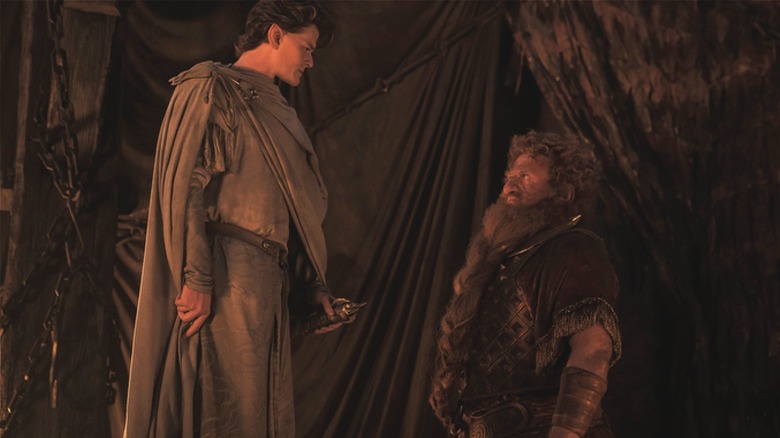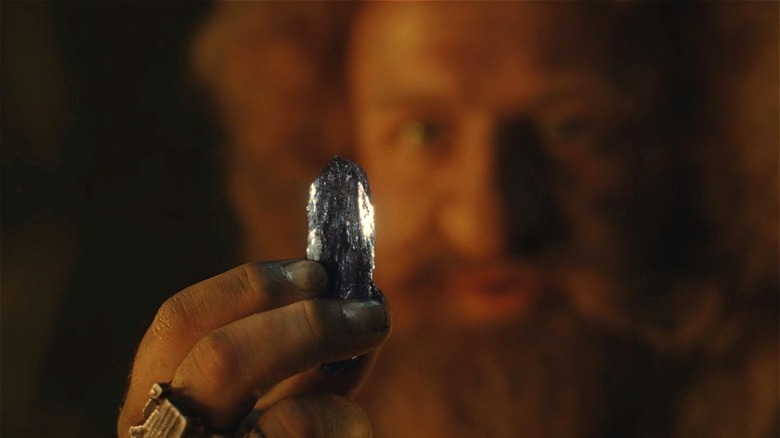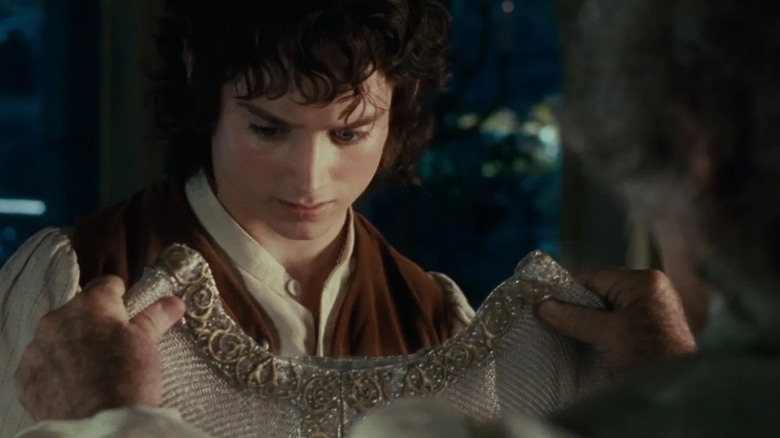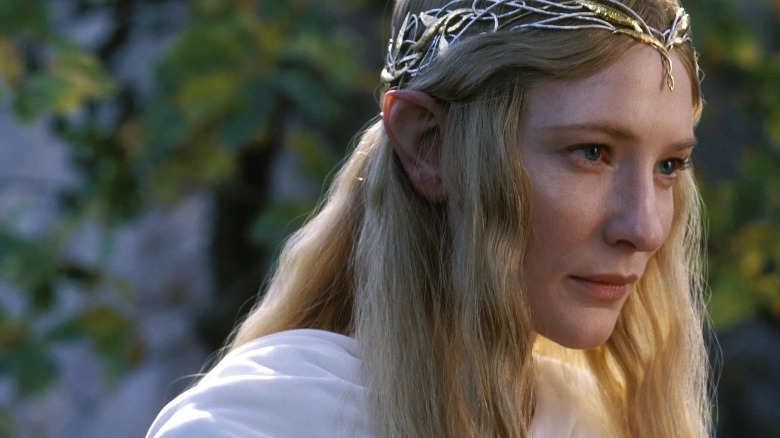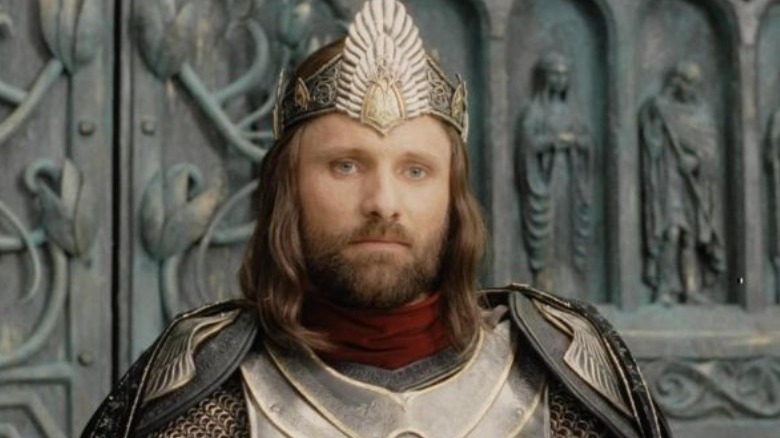The Rings Of Power Shows The Origins Of One Of The Most Important Elements In The Lord Of The Rings
Warning: Major spoilers ahead for "The Lord of the Rings: The Rings of Power."
One of the most beautiful things about J.R.R. Tolkien's fantasy world is the way in which even the smallest aspects of the story have major repercussions on the fate of Middle-earth. Mere chance encounters can be life-changing, and the discovery of a precious metal can spell doom and hope at the same time. Episode 4 of "The Lord of the Rings: The Rings of Power" leans into this aspect of Tolkien's saga and introduces a plot point that will essentially shape the course of events in Middle-earth. This occurs when Elrond (Robert Aramayo) finds out that his dear dwarf friend Durin IV (Owain Arthur) has discovered a rare, precious metal named mithril in the old mines of Khazad-dûm.
Fans of Tolkien's "The Lord of the Rings" are familiar with this powerful, lightweight metal, as mithril saves Frodo's life multiple times during his quest to destroy the One Ring. However, mithril plays an even larger role in the story, as its discovery and excavation creates a domino effect for events that will impact all races in Middle-earth and chart trajectories for the saga's primary characters. Let us dive into the history of mithril, its properties, and how it will come to affect the Second and Third Ages, especially within the context of the show.
Excavating the history of mithril, or true-silver
In Episode 4, Elrond is suspicious of Durin's shifty behavior, which leads him to go to the caves near Mirrormere. Durin arrives and believes Elrond wants the treasure for himself, but the elf assures him that he does not even know what said treasure is. After swearing an oath of secrecy, Durin reveals they've detected a metal like no other, called "gray-glitter," also known as "Mithril," when translated to Sindarin.
Although "The Rings of Power" situates Durin as an entryway into the discovery of Mithril, the precious metal was introduced by Tolkien in the twilight of the First Age. In the Song of Eärendil, it is mentioned that Elrond's father, Eärendil, who famously pleaded to the Valar for their aid against Morgoth, already knew about Mithril. Per this account, Eärendil's ship was made of Mithril and Elven glass, on which he fought the winged dragons of Morgoth during the War of Wrath. This is interesting, as Elrond is not aware of Mithril's origins or its connections to his father at this point.
But why is Mithril such a coveted ore? In Tolkien's "The Fellowship of the Ring," Gandalf described it as follows:
"Mithril! All folk desired it. It could be beaten like copper, and polished like glass; and the Dwarves could make of it a metal, light and yet harder than tempered steel. Its beauty was like to that of common silver, but the beauty of mithril did not tarnish or grow dim."
The dwarves' (re)-discovery of Mithril would gradually lead to excessive mining of the ore, from Moria towards Caradhras' dark pits. Just as Durin tells Elrond, Mithril brought wealth and prosperity to the dwarves, which led to objects being forged with the ore, including the heirlooms of Elendil.
How mithril affected the course of events in Middle-earth
Although Durin's father deemed the mining of mithril dangerous, canon dictates that excavations continue. Word of the precious ore soon spread, which led to the Ñoldor elves settling near the Misty Mountains. Over time, Celebrimbor would lead his master craftsmen, the Gwaith-i-Mírdain, to forge objects out of a mithril alloy known as ithildin, including the magical West-gate of Moria (seen in Peter Jackson's "The Fellowship of the Ring"). As ithildin markings are only visible by starlight, Frodo and co. could see them on Durin's gate after waiting for the stars to shine.
Before diving into how mithril spelled doom, let's look into how it helped forge alliances. After the Ñoldor founded Eregion near the mithril mines, a close friendship blossomed between the dwarves and the elves, which acts as a historical precursor to the playful, competitive bond between Legolas and Gimli in Jackson's trilogy. Another act of friendship, courtesy of mithril, is the chainmail armor gifted to Bilbo by Thorin during the Third Age. The mithril chainmail is later passed on to Frodo, without which he could've never accomplished his mission.
As mining continued during the Second Age, mithril was traced all the way to Númenor, wherein the ore was used for weaponry. However, after the fall of Númenor, mithril became more coveted, and the mines of Moria became the only source for it. Unfortunately, the dwarves' relentless excavation in Moria awakened an ancient evil named Balrog, who can be seen in Jackson's first film. By then, the dwarves in Moria were either killed or had fled, and the orcs didn't dare mine the ore due to Balrog. Interestingly, Balrog's fight with Gandalf leads to the latter's resurrection as Gandalf the White, who is basically Gandalf 2.0.
The forging of a powerful Elven ring, among other things
Mithril was used in one of the most powerful artifacts in Middle-earth history: Nenya, the elven ring of power given to Galadriel. Also known as the Ring of Adamant/Water, Nenya was forged by Celebrimbor and given to Galadriel for safekeeping after Sauron had forged the One Ring. The properties of Adamant and mithril helped strengthen the realm of Lothlórien and intensified Galadriel's desire to return to the West. Although the Galadriel (Morfydd Clark) in the show is a long way from this juncture, "The Rings of Power" will culminate with her receiving Nenya, which can only be done after the origins of mithril are revealed.
Another interesting tidbit about Nenya is that it was not visible to everyone, but Frodo could see it as it could not be hidden from the Ring-bearer. Among the many powers imbued by Nenya were protection and concealment from evil. As the show has taken some liberties with Tolkien's material, Nenya could come to play a greater role for Galadriel, whose actions could directly affect the fate of the Second Age in Middle-earth.
Apart from elves and dwarves, mithril was also coveted by the 15th king of Númenor, Tar-Telemmaitë, who was so obsessed with all things silver, that he commanded his servant to search for mithril. Over time, mithril became 10 times its volume in gold, which is foreshadowed by Durin, when he muses that mithril might even be more precious than gold. This is true, as the only way to obtain mithril during the Third Age was to use heirloom weapons or melt down existing objects to create new ones. Even Sauron himself was enamored by mithril, as his orcs would search for mithril-forged weapons and present them to him as tribute.
Other uses of mithril throughout Tolkien's saga
The blazing Elendilmir: The star of Elendil, aka Elendilmir, was a gem set on mithril and served as an heirloom of Númenor. Isildur wore the Elendilmir during the time he put on the One Ring to evade orcs, and the mithril gemstone was not invisible for some reason, as it blazed like "a red and wrathful star." The Elendilmir was later tracked by Saruman's men and given to Sauron as a gift. A second Elendilmir was forged in Rivendell after the first was lost with Isildur.
Durable battle gear: The helmets of the guards of the citadel of Minas Tirith were forged with mithril, as it was a reminder of the glory of Gondor's past.
Rebuilding legacy: After the great gate of Minas Tirith was broken by the Witch-king of Angmar, the gate was replaced by Gimli and the dwarves of Aglarond out of Mithril and steel.
The return of the king: The crown worn by Aragorn after the War of the Ring was forged with mithril by Arwen. Tolkien described it as follows: "...And the stars flamed in the sunlight, for they were wrought of gems by Arwen, daughter of Elrond; and the crown was bright in the morning, for it was wrought of mithril and gold."
The first four episodes of "The Lord of the Rings: The Rings of Power" are currently streaming on Prime Video.
